| Article ID | Journal | Published Year | Pages | File Type |
|---|---|---|---|---|
| 4700580 | Chemical Geology | 2008 | 11 Pages |
Water speciation in hydrated Na2O·2SiO2 (NS2), Na2O·4SiO2 (NS4), and Na2O·6SiO2 (NS6) glasses was analyzed by near-infrared (NIR) spectroscopy and low temperature static 1H nuclear magnetic resonance (NMR) spectroscopy. For each composition 6–9 glasses containing between 0.5 and 7.0 wt.% total water (measured by Karl–Fischer titration) were used to calibrate the molar absorption coefficients for the NIR combination bands near 4500 cm− 1 (OH groups) and near 5200 cm− 1 (H2O molecules). Noticeable disagreement was found between the water speciation derived from NIR spectra using an internally consistent calibration based on total water content and the water speciation determined by 1H NMR spectroscopy. The discrepancies are more pronounced for the evaluation of NIR peak areas (differences up to 55% in OH group content) than for the evaluation of peak heights (differences up to 35% in OH group content). Based on the NMR data we performed a new calibration for the NIR combination bands of the hydrous sodium silicate glasses. The molar absorption coefficients for the 4500 cm− 1 band (ε4500) and the 5200 cm− 1 band (ε5200) noticeably decrease with increasing Na2O content of the glasses from NS6 to NS2. The ε values for both bands also decrease with total water content in NS4 and NS6 glasses. The variation of ε values may be due to changes in the relative abundance of water subspecies, i.e. species exposed to strong or weak hydrogen bonding. Another explanation could be an incomplete separation of the combination bands from the tail of the fundamental OH stretching vibration bands and from the unassigned water-related band at 4000 cm− 1. Using the NMR-supported NIR calibration we calculated water species concentrations in the sodium silicate glasses as a function of total water content. At a total water content of 6.0 wt.%, the amount of water dissolved as OH groups is noticeably higher in the depolymerized glasses NS2 and NS4 (∼ 3.0 wt.%) than in the less depolymerized NS6 (∼ 2.5 wt.%). This observation implies that non-bridging oxygen, charge-compensated by sodium, promotes the formation of OH groups. No significant difference in water speciation was found between rapidly quenched glasses (∼ 150 K/s) and more slowly cooled glasses (∼ 2 K/s).
